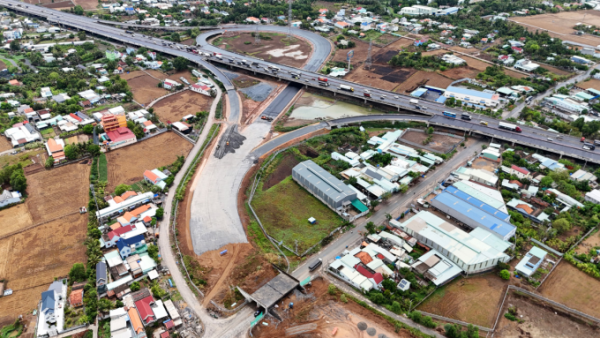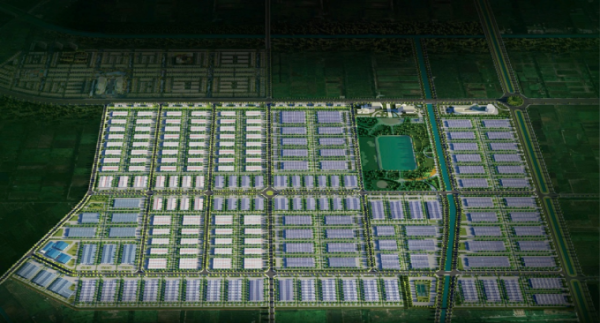
The development of Ho Chi Minh City’s Ring Road 3, one of Vietnam’s most significant infrastructure projects, is poised to drive industrial growth in Long An Province and the broader southern key economic region. By enhancing interregional connectivity and strengthening supply chains, the project is laying the foundation for a new wave of investment and economic activity.
Stretching over 76 kilometers and passing through Ho Chi Minh City, Dong Nai, Binh Duong, and Long An, Ring Road 3 represents a total investment of more than VND75.3 trillion (US$ 2.88 billion). Construction began in June 2023 and is being fast-tracked, with the Long An segment expected to open for technical traffic by National Day on Sept. 2, and full completion of the route targeted for 2026.
|
Ring Road 3’s segment in Long An one year after groundbreaking. Photo courtesy of Long An Province’s official portal |
Although the Long An section measures just 6.8 kilometers, the shortest along the route, it plays a strategic role by linking two major expressways, HCMC–Trung Luong and Ben Luc–Long Thanh, with the regional traffic network. The My Yen interchange in Ben Luc District is seen as a vital connection point, improving the flow of goods from Long An’s industrial zones in multiple directions, while reducing congestion on National Highway 1A and surrounding roads.
As the gateway between Ho Chi Minh City, the southeast region, and the Mekong Delta, Long An holds a unique geographic advantage for industrial development. The province has consistently ranked among the top performers nationwide, with one of the highest average annual growth rates in the Provincial Competitiveness Index (PCI) from 2005 to 2024. The expected administrative merger with Tay Ninh is also set to amplify Long An’s role in the national economic landscape.
Improved infrastructure has already helped Long An attract nearly 1,000 foreign direct investment (FDI) projects, primarily concentrated in its industrial parks. Projects like Ring Road 3, alongside others such as the Ben Luc–Long Thanh Expressway and the planned Ring Road 4, are creating a more synchronized and efficient regional infrastructure system, supporting greater connectivity and attracting new waves of investment.
One development set to benefit directly from these improvements is Prodezi Industrial Park, located near the My Yen interchange. With a prime location, Prodezi offers businesses fast access to major logistics hubs such as Long An International Port, Hiep Phuoc Port, Long Thanh International Airport, and key consumption centers across Ho Chi Minh City and the Mekong Delta.
 |
|
An artist impression of Prodezi Industrial Park in Ben Luc, Long An. Graphic courtesy of Prodezi |
According to Truong Khac Nguyen Minh, Deputy General Director of Prodezi Long An, Prodezi is not simply an industrial park but a strategic platform for companies looking to scale operations and integrate into the value chains of the southern economic region. “As the province enters a new phase of development with an expanded scale, we are committed to building a resilient and sustainable industrial ecosystem aligned closely with regional infrastructure.”
In addition to its locational advantages, Prodezi is also a pioneer in sustainable industrial development. The park is planned according to eco-industrial principles, incorporating circular economy models and international emissions standards. It targets 100% wastewater treatment compliance, with at least 25% of treated water reused on site. Moreover, a minimum of 20% of total energy consumption is planned to come from clean and renewable sources.
The convergence of synchronized transport infrastructure, a clear sustainability strategy, and strategic positioning is turning Prodezi into a standout model among Long An’s new-generation industrial parks. The project continues to attract interest from high-value FDI investors, particularly in the high-tech and eco-industrial sectors, who prioritize operational efficiency and environmental responsibility.